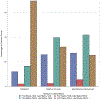Random forest analysis identifies change in serum creatinine and listing status as the most predictive variables of an outcome for young children on liver transplant waitlist
- PMID: 33232568
- PMCID: PMC8058171
- DOI: 10.1111/petr.13932
Random forest analysis identifies change in serum creatinine and listing status as the most predictive variables of an outcome for young children on liver transplant waitlist
Abstract
Young children listed for liver transplant have high waitlist mortality (WL), which is not fully predicted by the PELD score. SRTR database was queried for children < 2 years listed for initial LT during 2002-17 (n = 4973). Subjects were divided into three outcome groups: bad (death or removal for too sick to transplant), good (spontaneous improvement), and transplant. Demographic, clinical, listing history, and laboratory variables at the time of listing (baseline variables), and changes in variables between listing and prior to outcome (trajectory variables) were analyzed using random forest (RF) analysis. 81.5% candidates underwent LT, and 12.3% had bad outcome. RF model including both baseline and trajectory variables improved prediction compared to model using baseline variables alone. RF analyses identified change in serum creatinine and listing status as the most predictive variables. 80% of subjects listed with a PELD score at time of listing and outcome underwent LT, while ~70% of subjects in both bad and good outcome groups were listed with either Status 1 (A or B) prior to an outcome, regardless of initial listing status. Increase in creatinine on LT waitlist was predictive of bad outcome. Longer time spent on WL was predictive of good outcome. Subjects with biliary atresia, liver tumors, and metabolic disease had LT rate >85%, while >20% of subjects with acute liver failure had a bad outcome. Change in creatinine, listing status, need for RRT, time spent on LT waitlist, and diagnoses were the most predictive variables.
Keywords: infant; liver transplant; machine learning; outcome; pediatric; random forest analysis; waitlist.
© 2020 Wiley Periodicals LLC.
Conflict of interest statement
• Authors have no conflict of interest to disclose
Figures



Similar articles
-
Outcomes Analyses of Pediatric Acute Liver Failure Subjects Listed for Liver Transplantation.J Pediatr Gastroenterol Nutr. 2022 Jun 1;74(6):750-756. doi: 10.1097/MPG.0000000000003448. Epub 2022 Apr 19. J Pediatr Gastroenterol Nutr. 2022. PMID: 35442235 Free PMC article.
-
Validating a novel score based on interaction between ACLF grade and MELD score to predict waitlist mortality.J Hepatol. 2021 Jun;74(6):1355-1361. doi: 10.1016/j.jhep.2020.12.003. Epub 2020 Dec 14. J Hepatol. 2021. PMID: 33326814
-
Mortality Determinants in Children with Biliary Atresia Awaiting Liver Transplantation.J Pediatr. 2021 Jan;228:177-182. doi: 10.1016/j.jpeds.2020.09.005. Epub 2020 Sep 17. J Pediatr. 2021. PMID: 32950533
-
Does the pediatric end-stage liver disease score or hepatic artery resistance index predict outcome after liver transplantation for biliary atresia?Pediatr Surg Int. 2006 Sep;22(9):697-700. doi: 10.1007/s00383-006-1737-1. Epub 2006 Aug 1. Pediatr Surg Int. 2006. PMID: 16896815
-
Pediatric acute liver failure: Reexamining key clinical features, current management, and research prospects.Liver Transpl. 2022 Nov;28(11):1776-1784. doi: 10.1002/lt.26500. Epub 2022 May 27. Liver Transpl. 2022. PMID: 35557028 Free PMC article. Review.
Cited by
-
Artificial Intelligence in Pediatric Liver Transplantation: Opportunities and Challenges of a New Era.Children (Basel). 2024 Aug 15;11(8):996. doi: 10.3390/children11080996. Children (Basel). 2024. PMID: 39201931 Free PMC article. Review.
-
Use of machine learning models for the prognostication of liver transplantation: A systematic review.World J Transplant. 2024 Mar 18;14(1):88891. doi: 10.5500/wjt.v14.i1.88891. World J Transplant. 2024. PMID: 38576762 Free PMC article.
References
-
- Bucuvalas JC, Feng S. The questions not the answers: Outcomes after pediatric liver transplantation. Liver Transpl. 2016;22(11):1466–8. - PubMed
-
- Schlegel A, Muiesan P. Can we minimize wait-list mortality in young children with Biliary atresia? Liver Transpl. 2018;24(6):731–2. - PubMed
-
- van der Doef HPJ, van Rheenen PF, van Rosmalen M, Rogiers X, Verkade HJ, for pediatric liver transplantation centers of E. Wait-list mortality of young patients with Biliary atresia: Competing risk analysis of a eurotransplant registry-based cohort. Liver Transpl. 2018;24(6):810–9. - PubMed
-
- United Network for Organ Sharing. 2019. [Available from: https://optn.transplant.hrsa.gov/data/view-data-reports/national-data/.
MeSH terms
Substances
Grants and funding
LinkOut - more resources
Full Text Sources
Medical
Research Materials

